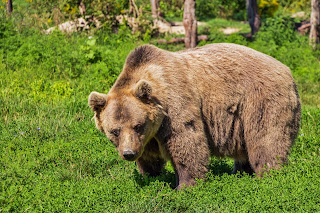Bear
Bear
Bears are carnivoran vertebrates of the family Ursidae. They are delegated caniforms, or doglike carnivorans. Albeit just eight types of bears are surviving, they are boundless, showing up in a wide assortment of environments all through the Northern Hemisphere and somewhat in the Southern Hemisphere. Bears are found on the mainlands of North America, South America, Europe, and Asia. Basic attributes of present day bears incorporate enormous bodies with stocky legs, long noses, little adjusted ears, shaggy hair, plantigrade paws with five nonretractile paws, and short tails.
While the polar bear is for the most part rapacious, and the monster panda takes care of for the most part on bamboo, the staying six species are omnivorous with fluctuated counts calories. Except for pursuing people and moms with their young, bears are commonly single creatures. They might be diurnal or nighttime and have a magnificent feeling of smell. In spite of their overwhelming form and ungainly step, they are proficient sprinters, climbers, and swimmers. Bears use covers, for example, buckles and logs, as their sanctums; most species possess their caves throughout the winter for an extensive stretch of hibernation, as long as 100 days.
Bears have been pursued since ancient occasions for their meat and hide; they have been used for bear-goading and different types of diversion, for example, being made to move. With their amazing physical nearness, they assume a conspicuous job in expressions of the human experience, folklore, and other social parts of different human social orders. In present day times, bears have gone under weight through infringement on their living spaces and unlawful exchange bear parts, including the Asian bile bear advertise. The IUCN records six bear species as helpless or jeopardized, and even least concern species, for example, the earthy colored bear, are in danger of extirpation in specific nations.The poaching and global exchange of these most undermined populaces are disallowed, yet at the same time continuous.
The English word "bear" originates from Old English bera and has a place with a group of names for the bear in Germanic dialects, for example, Swedish björn, additionally utilized as a first name. This structure is ordinarily supposed to be identified with a Proto-Indo-European word for "earthy colored", so that "bear" would signify "the earthy colored one". Notwithstanding, Ringe takes note of that while this derivation is semantically conceivable, a word signifying "earthy colored" of this structure can't be found in Proto-Indo-European. He proposes rather that "bear" is from the Proto-Indo-European word *ǵʰwḗr-~ *ǵʰwér "wild creature". This phrasing for the creature started as an untouchable evasion term: proto-Germanic clans swapped their unique word for bear—arkto—with this metaphorical articulation out of dread that talking the creature's actual name may make it show up. As per creator Ralph Keyes, this is the most established known code word.
Bear taxon names, for example, Arctoidea and Helarctos originate from the old Greek ἄρκτος (arktos), which means bear, as do the names "ice" and "antarctic", by means of the name of the star grouping Ursa Major, the "Incomparable Bear", conspicuous in the northern sky.
Bear taxon names, for example, Ursidae and Ursus originate from Latin Ursus/Ursa, he-bear/she-bear. The female first name "Ursula", initially got from a Christian holy person's name, signifies "little she-bear" (small of Latin ursa). In Switzerland, the male first name "Urs" is particularly well known, while the name of the canton and city of Bern is gotten from Bär, German for bear. The Germanic name Bernard (counting Bernhardt and comparable structures) signifies "bear-fearless", "bear-strong", or "striking bear". The Old English name Beowulf is a kenning, "honey bee wolf", for bear, thus meaning a courageous warrior.



Comments
Post a Comment